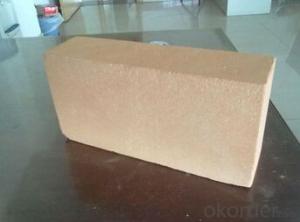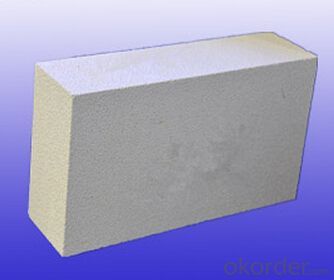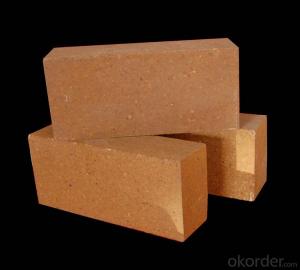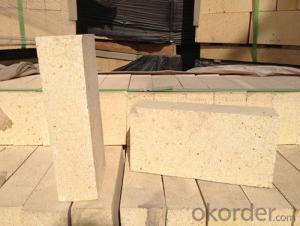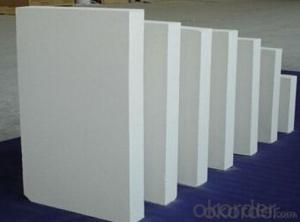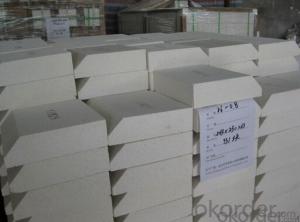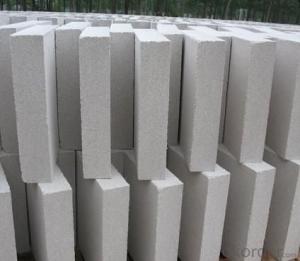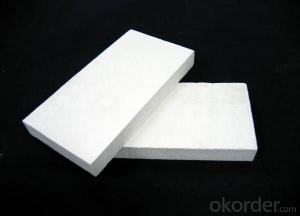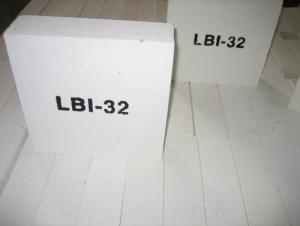Insulating Fire Brick - Refractory JM Mullite Insulation Brick ZDC-28
- Loading Port:
- Shanghai
- Payment Terms:
- TT OR LC
- Min Order Qty:
- 10 m.t.
- Supply Capability:
- 1000 m.t./month
OKorder Service Pledge
OKorder Financial Service
You Might Also Like
Refractory mullite insulating refractory brick JM 23
Okorder series heat insulation brick
Okorder series thermal insulation brick is an effective, energy saving, low carbon, environmental protection advanced, according to the ASTM standard manufacturing products. Okorder series products are best Li Ning and insulation in all types of industrial furnaces in the metallurgical field, aluminum, petrochemical, electric power and glass ceramic materials. They can be used as part of the working layer of thermal insulation or non - melting. Products have been widely used in the following furnace, achieved satisfactory results.
Application of heat preservation brick
Metallurgical Industry: blast furnace, hot blast furnace, heating furnace, etc..
Petrochemical Industry: ethylene cracking furnace, hydrogen production furnace, primary reformer, heating furnace, etc..
Ceramic industry: roller kiln, kiln, etc..
Glass industry: glass furnace regenerator, etc.
Carbon industry: carbon furnace, etc..
Aluminum electrolysis industry: aluminum reduction cell, etc.
Other industries: tunnel kiln, shuttle kiln, etc..
Advantages of heat insulation brick
Low thermal conductivity: more porosity will bring good thermal insulation effect, energy saving.
High crushing strength: high crushing strength, volume stability.
Low heat storage: small heat storage to absorb more heat, energy-saving effect is obvious.
Gao Chundu: iron, alkali metal impurity content is low.
The precise size: Brick size processing precision, special shape cutting and grinding, accelerate the brickwork.
Insulating brick picture


Common problem solutions
1. What products do you have?
We have all kinds of refractory bricks, refractory casting materials, mortar, cement, ceramic fiber products, etc..
Or you can browse our products to choose what you need.
2. How to control product quality?
With strict quality control system throughout the material selection and production process, we have the quality of refractory materials and ceramic fiber products to meet customer requirements.
From the selection of raw materials, the quality of our control to start. The quality certificate of the raw material is required, each batch of the products are to be tested in the use of the forward line. In the production process, the quality control by the workers, and then each piece of classification, and through the quality supervision and inspection.
3. Can you give me a brief introduction to the application of your product?
My company is mainly engaged in refractories in the steel, cement, glass, ceramics, petrochemical, electric power and other industries.
4. What information do you need if I need you?
In order to select the right products, we will provide us with information, such as the United States, technical data, order quantity, product application, etc..
If you have any questions, please contact us.
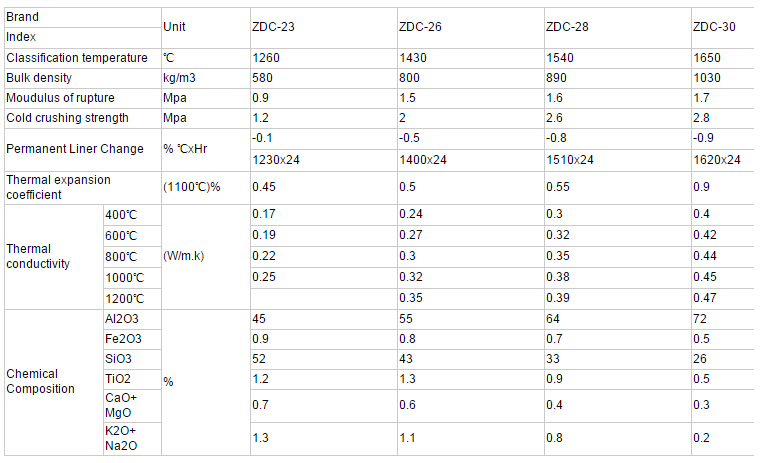
- Q: Are insulating fire bricks resistant to erosion?
- Yes, insulating fire bricks are generally resistant to erosion. Insulating fire bricks are made of lightweight materials such as alumina, silica, or a combination of both. These materials have excellent resistance to erosion caused by high temperatures, chemical reactions, and physical wear. They are designed to withstand extreme heat and harsh conditions, making them highly durable against erosion. Additionally, insulating fire bricks have low thermal conductivity, which means that they do not absorb or transfer heat easily, further protecting them from erosion. However, it is important to note that the resistance to erosion may vary depending on the specific composition and quality of the insulating fire bricks.
- Q: Can insulating fire bricks be used in the construction of brick kilns?
- Yes, insulating fire bricks can be used in the construction of brick kilns. These fire bricks are designed to withstand high temperatures and provide excellent insulation, making them ideal for lining the walls and floors of brick kilns. They help to retain heat, improve energy efficiency, and protect the kiln structure from thermal stress.
- Q: Can insulating fire bricks be used for soundproofing?
- Insulating fire bricks are primarily designed for high-temperature applications, such as lining kilns and furnaces, due to their ability to withstand extreme heat. While they do offer some level of sound insulation due to their dense composition, they are not specifically designed or recommended for soundproofing purposes. Insulating fire bricks are more effective at blocking heat transfer than sound transmission. For soundproofing purposes, other materials specifically engineered for acoustic insulation, such as mineral wool, fiberglass, or foam panels, are typically used. These materials are designed to absorb and dampen sound waves, providing better soundproofing results. Therefore, if your goal is to soundproof a space, it is recommended to use materials specifically designed for that purpose rather than relying on insulating fire bricks.
- Q: Are insulating fire bricks easy to handle and install?
- Insulating fire bricks are generally easy to handle and install. They are lightweight, making them easy to transport and carry around. Additionally, their shape and size are designed to be user-friendly, allowing for easy manipulation and installation. Most insulating fire bricks come with pre-drilled holes or grooves, which further simplifies the installation process. Moreover, these bricks can be easily cut or shaped to fit specific dimensions or requirements, making them highly versatile. Overall, insulating fire bricks are considered easy to handle and install, even for individuals with limited experience or knowledge in masonry work.
- Q: Can insulating fire bricks be used in the construction of pottery molds?
- Insulating fire bricks are indeed applicable for the construction of pottery molds. Crafted from lightweight refractory materials, these bricks possess exceptional heat insulation qualities. Specifically engineered for high-temperature applications like pottery kilns, they offer a range of benefits. When constructing pottery molds, it is imperative to utilize materials that can endure the kiln's intense heat. Insulating fire bricks can withstand temperatures of up to 3000°F (1650°C), rendering them ideal for pottery mold construction. They provide insulation to prevent heat dissipation and maintain consistent temperatures within the kiln, crucial for achieving the desired firing results. Moreover, insulating fire bricks can be conveniently shaped and cut to suit the designated mold design. Their lightweight nature also simplifies handling during the mold construction process. Additionally, the insulating properties of these bricks curtail energy consumption by preventing excessive heat loss, making them a cost-effective choice in the long term. All in all, insulating fire bricks prove to be a fitting option for constructing pottery molds due to their capacity to withstand high temperatures, offer insulation, and be easily molded to meet specific design requirements.
- Q: Can insulating fire bricks be used in the construction of BBQ pits?
- Yes, insulating fire bricks can be used in the construction of BBQ pits. These bricks are designed to withstand high temperatures and provide excellent insulation, making them ideal for creating a heat-resistant structure. They help to retain and distribute heat evenly, which is crucial for achieving optimal cooking conditions in a BBQ pit.
- Q: Do insulating fire bricks require a specific curing or drying process before use?
- Yes, insulating fire bricks typically require a specific curing or drying process before use. This is done to remove any moisture or volatile organic compounds (VOCs) that may be present in the bricks, as well as to ensure they achieve their maximum insulating properties. The curing or drying process for insulating fire bricks usually involves slowly heating the bricks to gradually increase their temperature. This allows any moisture or VOCs to be released without causing any cracks or damage to the bricks. The rate of temperature increase and the overall duration of the curing process can vary depending on the type and thickness of the bricks. It is important to follow the manufacturer's instructions and recommendations for the specific type of insulating fire bricks being used. This will ensure that the curing or drying process is carried out correctly and that the bricks are ready for use in high-temperature applications such as kilns, furnaces, or fireplaces. Neglecting to properly cure or dry the bricks may result in reduced insulating properties and potential cracking or failure of the bricks when exposed to high temperatures.
- Q: Are insulating fire bricks suitable for use in kilns and furnaces?
- Insulating fire bricks are a suitable choice for kilns and furnaces, offering excellent thermal insulation that is ideal for applications requiring high temperatures. These bricks are specifically designed to provide outstanding thermal insulation, making them perfect for kilns and furnaces. With their low thermal conductivity, they effectively minimize heat loss, thereby enhancing energy efficiency. Furthermore, their lightweight and durable nature allows for easy installation and long-lasting performance in high-temperature environments. Not only are they resistant to thermal shock, but they also withstand rapid temperature changes, making them a reliable option for kilns and furnaces. Overall, insulating fire bricks are an exceptional choice for insulation and the maintenance of high temperatures in kilns and furnaces.
- Q: Are insulating fire bricks resistant to freeze-thaw cycles?
- Generally, insulating fire bricks are resistant to freeze-thaw cycles. They are designed with low thermal conductivity and high resistance to thermal shock, making them durable and able to withstand extreme temperature variations, including freeze-thaw cycles. This resistance to freeze-thaw cycles is crucial in applications where the bricks are exposed to fluctuating temperatures, like in furnaces, kilns, and other high-temperature environments. Moreover, the insulating properties of these bricks minimize heat loss and prevent moisture penetration, further improving their resistance to freeze-thaw cycles. However, it is important to note that the composition and manufacturing process of the insulating fire bricks may vary, so it is recommended to consult the manufacturer's specifications and guidelines to ensure their suitability for the intended application.
- Q: Are insulating fire bricks chemically resistant?
- Insulating fire bricks exhibit a wide resistance to numerous substances chemically. These bricks are typically composed of top-notch refractory materials, including alumina, silica, or a combination of the two. These materials possess exceptional chemical resistance, thereby endowing insulating fire bricks with formidable protection against the corrosive effects of diverse chemicals. Nevertheless, it is essential to acknowledge that the chemical resistance of insulating fire bricks may vary depending on their distinct composition and manufacturing techniques. While they generally withstand most chemicals, there exists a possibility of certain aggressive chemicals or extreme circumstances potentially causing the degradation or erosion of the bricks over time. To guarantee the utmost chemical resistance of insulating fire bricks, it is advised to consult the manufacturer's specifications or seek expert counsel pertaining to specific applications. Such measures will ensure that the bricks are suitable for the intended chemical environment and will consistently perform as desired throughout their expected lifespan.
Send your message to us
Insulating Fire Brick - Refractory JM Mullite Insulation Brick ZDC-28
- Loading Port:
- Shanghai
- Payment Terms:
- TT OR LC
- Min Order Qty:
- 10 m.t.
- Supply Capability:
- 1000 m.t./month
OKorder Service Pledge
OKorder Financial Service
Similar products
Hot products
Hot Searches
Related keywords
